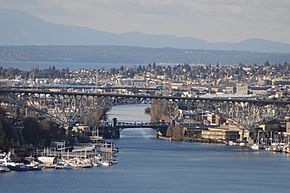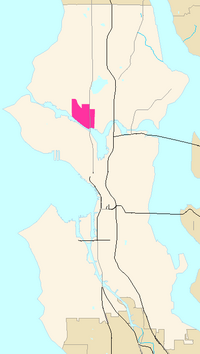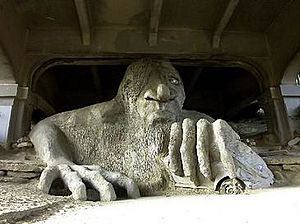Fremont, Seattle facts for kids
Quick facts for kids
Fremont
|
|
|---|---|
|
Seattle Neighborhood
|
|

The Fremont Cut of the Lake Washington Ship Canal, seen from the grounds of the St. Mark's Episcopal Cathedral complex, across Lake Union
|
|

Fremont's location in Seattle
|
|
| Country | United States |
| State | Washington |
| City | Seattle |
| City Council | District 6 |
| Neighborhood Council | Lake Union District |
| Police District | North Precinct, B2 |
| Legislative District | 43rd |
| Established | May 8, 1888 (first plat) Annexed to Seattle on May 3, 1891 |
| Founded by | Edward and Carrie Blewett |
| Named for | Fremont, Nebraska |
| Area | |
| • Total | 0.89 sq mi (2.3 km2) |
| Population | |
| • Total | 11,345 |
| • Density | 12,750/sq mi (4,922/km2) |
| ZIP Code |
98103, 98107
|
Fremont is a lively neighborhood in Seattle, Washington, United States. It's known for its unique art and community spirit. Fremont was once a separate town, but it became part of Seattle in 1891. It was named after Fremont, Nebraska, the hometown of its founders, Luther H. Griffith and Edward Blewett.
Contents
Exploring Fremont's Location
Fremont is located along the Fremont Cut of the Lake Washington Ship Canal. This canal connects Lake Union to Puget Sound. To the south, you'll find Queen Anne. To the east is Ballard, and to the north are Phinney Ridge and Wallingford.
While its exact borders can be a bit flexible, Fremont generally includes the Ship Canal to the south. Stone Way N. is to the east, N. 50th Street to the north, and 8th Avenue N.W. to the west.
Main Roads and Bridges
Fremont has several important roads. Fremont Avenue N. and Aurora Avenue N. run north and south. N. 46th, 45th, 36th, and 34th Streets run east and west.
The Aurora Bridge (also called the George Washington Memorial Bridge) carries Aurora Avenue (State Route 99) over the Ship Canal. It connects Fremont to Queen Anne Hill. The Fremont Bridge carries Fremont Avenue over the canal. It leads to the base of Queen Anne Hill. A busy shopping area is located on Fremont Avenue N., just north of the Fremont Bridge.
Fremont's Unique Vibe
Fremont is often called "The People's Republic of Fremont" or "The Artists' Republic of Fremont." It was once a hub for unique and alternative ideas. While it has changed a bit since the 1990s, it still keeps its artistic and quirky charm.
Famous Fremont Landmarks

One of Fremont's most famous landmarks is the Fremont Troll. This giant concrete sculpture is 18 feet (5.5 meters) tall. It shows a troll crushing a Volkswagen Beetle car in its hand. The Troll was created in 1990 and sits under the north end of the Aurora Bridge. In 2005, the street under the bridge, leading to the Troll, was renamed Troll Avenue N.
Fremont is also home to a controversial statue of Vladimir Lenin. An art lover from Washington state found it in Slovakia after the fall of the Communist government in 1989. He brought the statue to Fremont with money he raised.
You'll also find other interesting signs and sculptures around Fremont. Some signs give funny advice like "set your watch back five minutes" or "throw your watch away." Other landmarks include the Fremont Rocket, which is part of an old airplane shaped like a missile. There's also the outdoor sculpture Waiting for the Interurban, which shows people waiting for a streetcar.
Since the early 1970s, many Fremont residents have called their neighborhood "The Center of the Universe." This phrase even appears on a large "Welcome" sign. An unofficial motto, "De Libertas Quirkas" (which means "Freedom to be Peculiar" in a playful Latin), is often used in brochures and websites about the area.
Events and Community Places
The Fremont Arts Council organizes several popular yearly events in Fremont. One fun event is Troll-a-ween, which celebrates the famous Fremont Troll.
Schools and Libraries
A very important part of Fremont is the block on Linden Avenue N. This block includes the B.F. Day Elementary School and the B.F. Day Playground. B.F. Day Elementary is the oldest school in the Seattle school district that has been open continuously since it was founded in 1892.
Another long-standing community place is the Fremont branch of the Seattle Public Library. There was a small library in Fremont even before it joined Seattle in 1891. When Fremont became part of Seattle, this library became the city's first branch library. The building you see today was built in 1921.
Parks and Recreation
Besides the B.F. Day playfield, Fremont has three smaller public parks. Fremont Peak Park is just south of N. 45th Street. Ross Park and Playground are at 3rd Avenue NW and NW 43rd Street. A.B. Ernst Park is next to the library. Ernst Park was named after Ambrose Ernst, a Fremont resident who was known as the "Father of City Playfields." He helped create Seattle's park plan.
The Burke–Gilman Trail, a popular path for walking and biking, goes through Fremont. It runs just north of the Lake Washington Ship Canal. The large Gas Works Park is also nearby, just east of Fremont on the north shore of Lake Union.
Companies and Organizations in Fremont
Fremont is home to many interesting companies and groups. Theo Chocolate has its factory and store here, where you can learn about chocolate making. The company Cutter & Buck, which makes golf and daywear, has its main office in Fremont. Brooks Sports, a well-known athletic shoe and apparel company, also has its headquarters here.
Fremont has several breweries, including Hale's Ales brewery and Fremont Brewing. In the past, the original Redhook breweries were also located in Fremont.
Many technology companies have offices in Fremont, especially along the Lake Washington Ship Canal. These include Google, which opened offices here in 2006. The company behind Geocaching.com is also headquartered in Fremont. Other tech companies like Adobe Systems, the Allen Institute for Brain Science, SDL PLC, Groundspeak, Impinj, Sporcle, and Tableau Software also have a presence in the neighborhood.
Fremont is also home to several nonprofit organizations. These include Literacy Source, which helps people learn to read, and Provail, which provides services for people with disabilities.
A unique building on Leary Way, a street that connects Fremont to the Ballard neighborhood, once housed Reciprocal Recording studio. This famous studio, run by Seattle producer Jack Endino, recorded early music from bands like Nirvana, including their first demos and their debut album Bleach.
Images for kids
-
Fremont Branch of the Seattle Public Library






